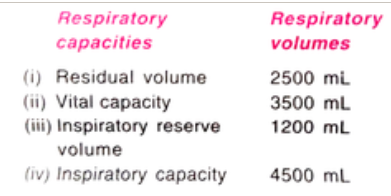Listed below are four respiratory capacities (i-iv) and four jumpled respiratiory volumes of a normal human adult.
Respiratory volumes and capacitiesVolume of air(i)Residual volume1200 mL(ii)Vital capacity4500 mL(iii)Inspiratory reserve volume2500 mL(iv)Inspiratory capacity3500 mL
(2)2500 mL.(3) 4500 mL
(3) 1200 mL.(4)2500 mL
(4) 3500 mL, (1) 1200 mL
(1) 4500 mL, (2) 3500 mL
The correct Answer is:C
Inspiratiory capoacity (IC) is the maximum amount of air that can be inspired after a normal expiration .IC =TV+IRV. It is 3500 mL in adult male and 2400 mL inadult female.
Residual volume (RV) is ythe amount of air remaining in the lungs after of forced exhalation.OIts average value is 1200 mL and 1100 mL in adult male and female respectively.
Similar Questions
Listed below are four respriatory capacities (i-iv) and four jumbled respiratory volumes of a normal human adult

View Solutionlisted below are four respiratory capacities (A-D) and four jumbled respiratory volumes of a normal human adult
Respiratory capacities− Respiratory volumesResidual volume− 2500 mLVital capacit− 3500 mLInspiratory reserve volume− 1200mLInspiratory capacity− 4500mL
Which one of the following is the correct matching of two capacities and volumes
View Solution
Knowledge Check
From the following relationship between respiration volumes and capacities, mark the correct option.
(i) Inspiratory Capacity (IC) = Tidal Volume + Residual Volume
(ii) Vital Capacity (VC) = Tidal Volume (TV) + Inspiratory Reserve Volume (IRV) + Expiratory Reserve Volume (ERV)
(iii) Residual Volume (RV) = Vital Capacity (VC) - Inspiratory Reserve Volume (IRV)
(iv) Tidal Volume (TV) = Inspiratory Capacity (IC) - Inspiratory Reserve Volume (IRV)A(i) Incorrect, (ii) Incorrect, (iii) Incorrect, (iv) CorrectB(i) Incorrect, (ii) Correct, (iii) Incorrect, (iv) CorrectC(i) Correct, (ii) Correct, (iii) Incorrect, (iv) CorrectD(i) Correct, (ii) Incorrect, (iii) Correct, (iv) Incorrect
The quantity 1100-1200mL in the respiratory volumes of a normal human adult refers to
View SolutionFrom the following relationship between respiration volumes and capacities, mark the correct option.
(i) Inspiratory Capacity (IC) = Tidal Volume + Residual Volume
(ii) Vital Capacity (VC) = Tidal Volume (TV) + Inspiratory Reserve Volume (IRV) + Expiratory Reserve Volume (ERV)
(iii) Residual Volume (RV) = Vital Capacity (VC) - Inspiratory Reserve Volume (IRV)
(iv) Tidal Volume (TV) = Inspiratory Capacity (IC) - Inspiratory Reserve Volume (IRV)
View SolutionFrom the following relationship between respiration volumes and capacities, mark the correct option.
(i) Inspiratory Capacity (IC) = Tidal Volume + Residual Volume
(ii) Vital Capacity (VC) = Tidal Volume (TV) + Inspiratory Reserve Volume (IRV) + Expiratory Reserve Volume (ERV)
(iii) Residual Volume (RV) = Vital Capacity (VC) - Inspiratory Reserve Volume (IRV)
(iv) Tidal Volume (TV) = Inspiratory Capacity (IC) - Inspiratory Reserve Volume (IRV)
View SolutionFrom the following relationship between respiration volumes and capacities, mark the correct option.
(i) Inspiratory Capacity (IC) = Tidal Volume + Residual Volume
(ii) Vital Capacity (VC) = Tidal Volume (TV) + Inspiratory Reserve Volume (IRV) + Expiratory Reserve Volume (ERV)
(iii) Residual Volume (RV) = Vital Capacity (VC) - Inspiratory Reserve Volume (IRV)
(iv) Tidal Volume (TV) = Inspiratory Capacity (IC) - Inspiratory Reserve Volume (IRV)
View SolutionMatch the items given in Column I with those in Column II and select the correct option given below :
Column IColumn II(a)Tridal volume (i)2500-3000 mL(b)Inspiratory Reserve volume (ii)1100-1200 mL (c)Expiratory Reserve volume(iii)500- 550 mL (d)Residual volume(iv)1000-1100mL
View SolutionArrange the following in an ascending order of volume
1 expiratory reserve volume
2 inspiratory capacity
3 tidal volume
4 residual volume
View SolutionTidal Volume and Expiratory Reserve Volume an athlete is 500 mL and 1000 mL respectively. What will be his Expiratory Capacity if the Residual Volume is 1200 mL?
View Solution